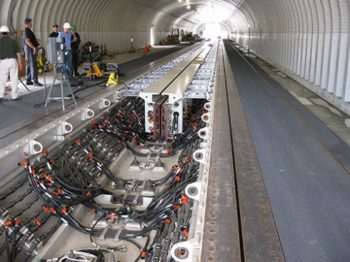

|
|
USS Ford: Sigh...
 [US Naval Institute Blog] If you can’t launch your airwing, you don’t have a carrier. [US Naval Institute Blog] If you can’t launch your airwing, you don’t have a carrier.
You need to read the whole thing to appreciate the challenges ahead, but for this post, let’s look just at EMALS.
Progress has been made, but there are still some items that in the 1QCY18 should give everyone pause.
EMALS testing in 2015 discovered excessive airframe stress during launches of F/A-18E/F and EA-18G with wing-mounted 480-gallon EFTs. The Navy discovered similar problems with 330-gallon EFTs on the F/A-18A-D. Additionally, end-of-stroke dynamics with heavy wing stores were discovered for the F/A-18E/F and EA-18G, which would limit maximum launch speed.
• CVN 78 includes several systems that are new to aircraft carriers; four of these systems stand out as being critical to flight operations: EMALS, AAG, DBR, and AWEs. Overall, the poor reliability demonstrated by AAG and EMALS and the uncertain reliability of DBR and AWEs pose the most significant risk to CVN 78 IOT&E. The Navy is testing all four of these systems for the first time in their shipboard configurations aboard CVN 78.
EMALS testing to date has demonstrated that EMALS should be able to launch aircraft planned for the CVN 78 air wing. However, the system demonstrated poor reliability during developmental testing suggesting operational difficulties lie ahead for meeting requirements and in achieving success in combat.
• In its current design, EMALS is unlikely to support high-intensity operations expected in combat.
At the current reliability, EMALS has a 9 percent chance of completing the 4-day surge and a 70 percent chance of completing a day of sustained operations as defined in the design reference mission without a critical failure.
• The reliability concerns are exacerbated by the fact that the crew cannot readily electrically isolate EMALS components during flight operations.
Based on current reliability estimates, CVN 78 is unlikely to be able to conduct the type of high-intensity flight operations expected during wartime.
• CVN 78 is unlikely to achieve its Sortie Generation Rate (SGR) (number of aircraft sorties per day) requirement. The threshold requirement is based on unrealistic assumptions including fair weather and unlimited visibility, and that aircraft emergencies, failures of shipboard equipment, ship maneuvers, and manning shortfalls will not affect flight operations.
The Navy analysis indicates the ship is sensitive to manpower fluctuations. Workload estimates for the many new technologies such as catapults, arresting gear, radar, and weapons and aircraft elevators are not well understood. Some of these concerns have required redesignation of some berthing areas and may require altering standard manpower strategies to achieve mission accomplishment.
Posted by: 3dc 2018-02-17 |
| http://www.rantburg.com/poparticle.php?ID=508298 |
|


 [US Naval Institute Blog] If you can’t launch your airwing, you don’t have a carrier.
[US Naval Institute Blog] If you can’t launch your airwing, you don’t have a carrier.